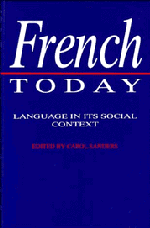Book contents
- Frontmatter
- Contents
- List of figures and maps
- List of tables
- Notes on the contributors
- Acknowledgements
- Introduction
- 1 French: a planned language?
- 2 Sociosituational variation
- 3 Regional variation in France
- 4 The other languages of France: towards a multilingual policy
- 5 The migrant languages of Paris
- 6 Gender and language in French
- 7 The reform of the writing system
- 8 Alternative French
- 9 New words for new technologies
- 10 Language and style in politics
- 11 French and French-based Creoles: the case of the French Caribbean
- 12 French in Africa
- 13 French in Canada
- 14 Sociolinguistic variation and the linguist
- Bibliography
- Index
6 - Gender and language in French
Published online by Cambridge University Press: 05 June 2012
- Frontmatter
- Contents
- List of figures and maps
- List of tables
- Notes on the contributors
- Acknowledgements
- Introduction
- 1 French: a planned language?
- 2 Sociosituational variation
- 3 Regional variation in France
- 4 The other languages of France: towards a multilingual policy
- 5 The migrant languages of Paris
- 6 Gender and language in French
- 7 The reform of the writing system
- 8 Alternative French
- 9 New words for new technologies
- 10 Language and style in politics
- 11 French and French-based Creoles: the case of the French Caribbean
- 12 French in Africa
- 13 French in Canada
- 14 Sociolinguistic variation and the linguist
- Bibliography
- Index
Summary
Definition of gender as a grammatical category
The origin of gender, as a grammatical category, has given rise to a variety of theories and suppositions. It was thought that the distinction between the sexes led to the division between genders in grammars. This hypothesis does not, of course, account for the gender of a multitude of nouns which are inanimate and cannot in any way be linked to one sex or another. It is still currently admitted that grammatical gender is rather arbitrary and is not a static category: for example nouns like doute were feminine at first, and from the sixteenth century its gender started fluctuating and became masculine only at the beginning of the seventeenth century. Yet, this arbitrary nature of gender in French was challenged by Bidot (1925), by Mel'cuk and, more recently by Tucker, Lambert and Rigault (1977) who established that the proportion of nouns covered by assignment rules is very high. The semantic assignment rules take precedence over the morphological rules but the major assignment rules are phonological. This led G. Corbett (1991: 61) to conclude that ‘French, often quoted as a case for proving that gender is irrational, has a system of gender assignment rules.’
- Type
- Chapter
- Information
- French TodayLanguage in its Social Context, pp. 121 - 138Publisher: Cambridge University PressPrint publication year: 1993
- 1
- Cited by



